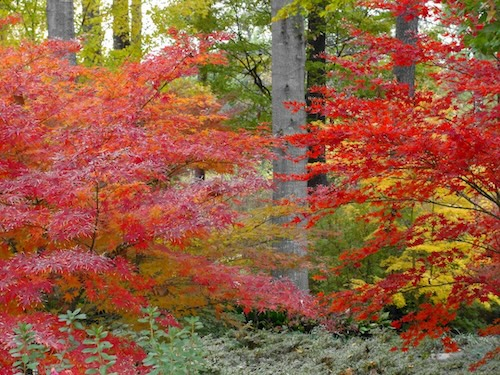
The SFA Ruby Mize Azalea Garden boasts an amazing maple collection with peak fall color from mid-November to early December.
November 17, 2025 - As summer’s grip finally loosens, and crisp, cooler air settles over East Texas, our forests and neighborhoods begin their quiet transformation. Fall color is one of nature’s most noticeable gifts, and even though it can vary greatly from year to year, it always manages to lift our spirits after the long, exhausting heat. The turning of the leaves is not just a sign of seasonal change; it is a glimpse into one of the most fascinating biological processes in the plant world.
During spring and summer, trees are busy converting sunlight into food through photosynthesis. Chlorophyll, the green pigment essential to this process, dominates the leaf and masks the other pigments inside. As daylight shortens and temperatures cool, trees begin preparing for dormancy. Chlorophyll production slows, revealing the pigments that have been there all along: carotenoids, which create golden yellows and oranges, and then anthocyanins, which produce vivid reds and purples.
Carotenoids are always present in the leaves, giving hickories, elms, and maples their buttery yellow tones. Anthocyanins, however, are produced in response to cool nights and bright days, forming when sugars get trapped in the leaves. This combination often results in brilliant shades of scarlet and maroon in dogwoods, red maples, and sweetgums. The balance of these pigments, along with genetics, weather, and soil moisture, determines each tree’s fall display.
The best autumn color occurs when we have had a warm, moist growing season followed by sunny, cool days and crisp, dry nights. Drought or early freezes, on the other hand, can mute the colors or cause leaves to drop early. Each fall in East Texas is unique. Sometimes the palette glows with fiery reds and oranges, while other years it leans toward subdued golds and russets. And sadly, some years we only get tattered yellows and browns.
If you want to enjoy fall color in your own yard, plant trees and shrubs known for their reliable displays. Excellent choices for our region include baldcypress, black gum, Chinese pistache (male cultivars only), flowering dogwood, ginkgo (males cultivars only), Japanese maples, red maples, red oaks, sweetgum, and white oak.
Beyond beauty, fall foliage plays an important ecological role. As leaves decompose, they enrich the soil, feed beneficial organisms, and contribute to the forest’s nutrient cycle. Leaving some fallen leaves beneath your trees can create habitat for overwintering insects and protect the soil from erosion. Nature’s leaf litter is her mulch; it insulates, nourishes, and sustains life below the surface.
For those who love a scenic view, the Ruby Mize Azalea Garden at SFA Gardens in Nacogdoches has a world class collection of Japanese maples. Peak color there usually occurs from mid-November through early December, although timing depends on weather conditions each year. Follow SFA Gardens on Facebook for weekly updates.









